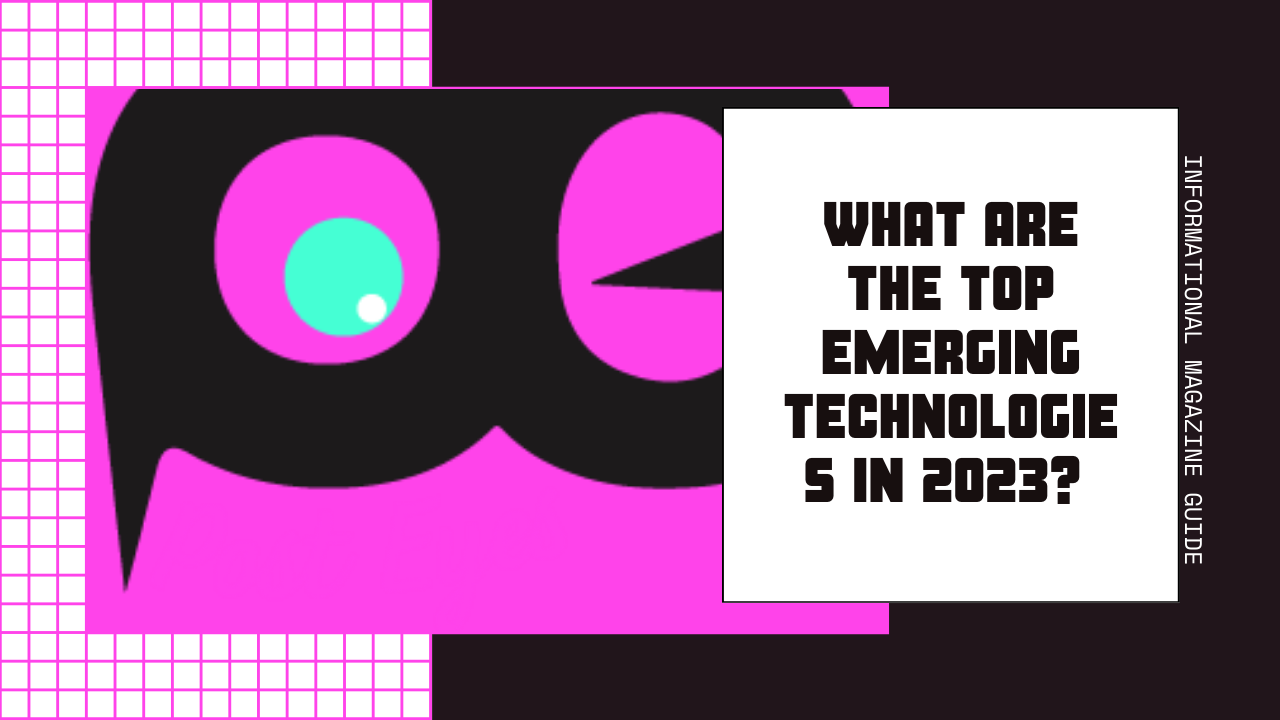Several emerging technologies are making significant strides, influencing various industries and shaping the future of innovation. These technologies span a wide range of domains, including artificial intelligence, biotechnology, connectivity, and more. In this exploration, we will delve into some of the top emerging technologies in 2023 and their potential impact on society, business, and daily life.
Artificial Intelligence (AI) and Machine Learning (ML):
Explainable AI (XAI): As AI systems become more sophisticated, the need for transparency and interpretability has led to the development of Explainable AI. XAI ensures that AI models provide clear explanations for their decisions, fostering trust and understanding.
Federated Learning: Federated learning allows machine learning models to be trained across decentralized devices or servers without exchanging raw data. This approach enhances privacy and security by keeping sensitive information localized while still benefiting from collective learning.
AI in Drug Discovery: AI is revolutionizing drug discovery processes by accelerating the identification of potential drug candidates and predicting their efficacy. The integration of AI and ML in pharmaceutical research is leading to more efficient and targeted drug development.
5G Technology:
Ultra-Reliable Low Latency Communication (URLLC): 5G technology goes beyond faster data speeds; URLLC ensures ultra-reliable and low-latency communication, making it suitable for applications that demand real-time responsiveness, such as autonomous vehicles and critical healthcare systems.
Edge Computing with 5G: The combination of 5G and edge computing brings computing resources closer to the point of data generation. This reduces latency and enhances the performance of applications that require rapid data processing, such as augmented reality (AR) and virtual reality (VR).
Massive Machine Type Communications (mMTC): 5G supports the connectivity of a massive number of devices simultaneously, paving the way for the Internet of Things (IoT) at an unprecedented scale. mMTC is crucial for smart cities, industrial automation, and other IoT applications.
Biotechnology and CRISPR Technology:
Synthetic Biology: Advances in synthetic biology enable the design and construction of new biological entities for various applications, including biofuels, pharmaceuticals, and materials. Customizing biological systems at the genetic level holds immense innovation potential.
CRISPR-Cas Gene Editing: CRISPR-Cas technology continues to evolve, allowing precise and targeted gene editing. This technology holds promise for treating genetic disorders, developing genetically modified organisms, and advancing personalized medicine.
Bioinformatics: The integration of biotechnology and information technology has led to the growth of bioinformatics. This field involves the analysis and interpretation of biological data, driving advancements in genomics, proteomics, and systems biology.
Quantum Computing:
Quantum Supremacy: Quantum computing has achieved milestones like quantum supremacy, where a quantum computer performs a task faster than the most advanced classical computers. Quantum supremacy opens up new possibilities for solving complex problems in cryptography, optimization, and simulation.
Quantum Communication: Quantum communication utilizes the principles of quantum mechanics to enable secure communication through quantum key distribution (QKD). This technology has the potential to enhance the security of data transmission.
Quantum Machine Learning: Quantum computing intersects with machine learning, giving rise to quantum machine learning algorithms. These algorithms leverage the unique properties of quantum systems to perform complex computations, leading to advancements in optimization and pattern recognition.
Internet of Things (IoT):
5G-enabled IoT: The integration of 5G technology enhances the capabilities of IoT by providing high-speed, low-latency connectivity. This is particularly impactful for applications like smart cities, industrial IoT, and connected vehicles.
Edge Computing for IoT: Edge computing complements IoT by processing data closer to the source, reducing latency and bandwidth usage. This is crucial for applications where real-time data processing is essential, such as in smart homes and industrial automation.
IoT Security Solutions: As the number of connected devices increases, the importance of IoT security grows. Emerging technologies focus on robust IoT security solutions, including secure device provisioning, encryption, and threat detection.
Augmented Reality (AR) and Virtual Reality (VR):
AR in Retail and Commerce: AR enhances the consumer shopping experience by enabling virtual try-ons, product visualizations, and interactive advertisements. Retailers are leveraging AR to bridge the gap between online and in-store experiences.
VR in Training and Simulation: VR is increasingly used for training simulations in various industries, including healthcare, aviation, and manufacturing. It provides realistic, immersive environments for hands-on learning and skill development.
Extended Reality (XR): XR encompasses AR, VR, and mixed reality (MR), offering a spectrum of immersive experiences. XR technologies are evolving to create more seamless and interactive virtual worlds.
Robotics and Automation:
Soft Robotics: Soft robotics involves the development of flexible and adaptive robotic systems inspired by biological structures. These robots are well-suited for tasks that require interaction with delicate objects or navigating complex environments.
Collaborative Robots (Cobots): Cobots are designed to work alongside humans, facilitating collaboration in various industries. They enhance productivity and efficiency by automating repetitive tasks while ensuring a safe working environment.
Autonomous Vehicles: The advancement of autonomous vehicle technology, including self-driving cars and drones, continues to progress. This technology holds the potential to revolutionize transportation, logistics, and delivery services.
Cybersecurity Innovations:
Zero Trust Security Model: The zero-trust security model, which assumes that no entity, whether inside or outside the network, should be trusted by default, is gaining prominence. This approach enhances security by continuously verifying identities and devices.
AI-driven Cybersecurity: AI is playing a crucial role in cybersecurity by identifying and mitigating threats in real time. AI-driven cybersecurity solutions use machine learning to detect patterns indicative of cyber attacks and respond proactively.
Quantum-safe Cryptography: With the advent of quantum computing, there is a focus on developing quantum-safe cryptographic algorithms. These algorithms aim to withstand attacks from quantum computers that could compromise current encryption methods.
Blockchain and Decentralized Finance (DeFi):
Decentralized Finance (DeFi): DeFi leverages blockchain technology to create decentralized financial systems, enabling activities such as lending, borrowing, and trading without traditional intermediaries. This has the potential to reshape the financial industry.
Blockchain in Supply Chain: Blockchain is being applied to supply chain management to enhance transparency, traceability, and efficiency. It provides a secure and immutable ledger for tracking the movement of goods across the supply chain.
Smart Contracts: Smart contracts, self-executing contracts with the terms directly written into code, automate and enforce contractual agreements on blockchain platforms. They streamline processes in various industries, including legal, real estate, and logistics.
Energy Storage and Renewable Technologies:
Advanced Battery Technologies: Advances in battery technologies, including solid-state batteries and lithium-sulfur batteries, aim to enhance energy storage capacity and efficiency. This is critical for supporting renewable energy sources and electric vehicles.
Hydrogen Fuel Cells: Hydrogen fuel cells are gaining attention as a clean energy alternative for various applications, including transportation and power generation. They offer a sustainable and zero-emission energy solution.
Advanced Solar Technologies: Innovations in solar technologies, such as perovskite solar cells and transparent solar panels, aim to improve the efficiency and versatility of solar energy harvesting. These advancements contribute to the broader adoption of renewable energy.
Conclusion:
The top emerging technologies in 2023 reflect a dynamic landscape of innovation, with each technology contributing to the transformation of industries and society as a whole. From the convergence of AI and 5G to the potential of quantum computing, these technologies are shaping the future of how we live, work, and interact. As these trends continue to evolve, businesses, policymakers, and individuals need to stay informed and adapt to the opportunities and challenges presented by these emerging technologies. The ongoing integration and responsible deployment of these technologies have the potential to address complex global challenges and drive positive societal impact.





